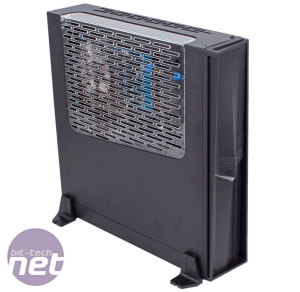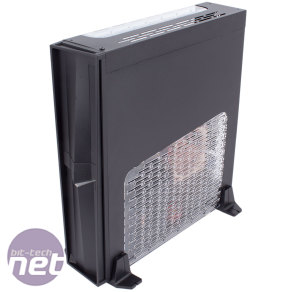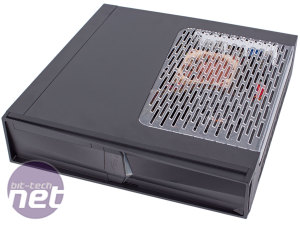
Performance Analysis
With our current GPU, we don’t have any cases to compare to, so we ran a test on an open test bench to give us a baseline of performance. In this state, our graphics card reached a delta T of 38°C – nice and low, as you’d expect given it has maximum access to cool air. Pleasingly, it only warmed up very slightly in the RVZ02, to 39°C, at least when the case was stood vertically. Horizontally, however, where the graphics card is very close to the floor, it increases by a whole 12°C. This still isn’t a disastrous result but high end gaming systems will definitely be better off in terms of average clock speeds and noise output stood vertically.The CPU cooling results tell an interesting story. Without the graphics card under load, our AMD APU reaches a delta T of 64°C vertically and 65°C horizontally – essentially no difference, and on par with other cases we’ve seen such as the Cooler Master Elite 130, which is a good result considering it has no fans of its own.
When you place the GPU under load as well, however, the horizontal arrangement seems best. It only increases by a couple of degrees Celsius, which is nothing to worry about – even the open test bench heated up by 4°C when we added the graphics card to the mix. However, when vertical, the temperature creeps up to a delta T of 73°C, possibly because of added heat rising through the case.
Whatever the reason, we still advise standing the case vertically if you’re building a powerful gaming system in the RVZ02, but also recommend making maximum use of what little space there is for a CPU cooler – the bigger fan you can use and the closer it can be to the side vents the better. If you’re building a less powerful rig or a HTPC, for example, then either orientation should provide adequate cooling. Overally the RVZ02 does well given that it doesn’t have any fans; this has obvious benefits for noise output as well – it’s as quiet as your other hardware is, producing no sound of its own.
Conclusion
In shrinking the width (or height, depending on how you look at it) of the RVZ02 compared to the RVZ01, SilverStone has developed a chassis that’s even more living room friendly – it’s barely bigger than an Xbox One (which has an external power supply, we should note), a console that would be put to shame by the performance you could theoretically achieve here. Remarkably, the case has actually been made more user-friendly than before – there really isn’t any part of the building or even the cable tidying process that’s particularly challengingOf course, a case like this does place limits on the hardware you can use but it still allows you to use monster graphics cards. Besides, the mini-ITX form factor really isn't very limiting at all these days for a single GPU system – there's a great selection of motherboards with the latest chipsets and SilverStone itself has plenty of accessories suitable for a build in the RVZ02. For example, there's the awesome SX600-G SFX PSU, and it also offers a range of short cables and low profile coolers. On that topic, the 58mm of cooler clearance is the biggest limit of the case. We wouldn't go pushing our CPU much past stock speed unless you want to suffer high temperatures and/or noise output. As long as you stick to this and use a decent cooler, you'll have little to worry about thank to the case's fairly unrestricted airflow.
There are some downsides too, of course. For example, in places the case feels a bit rough around the edges – the plastic feet, front IO cover and lack of any anti-vibration are all points that spring to mind, but none of them take away from what the RVZ02 achieves. We're also not sure about the windowed edition's lack of dust filters. Thing could get clogged up pretty quickly, which is never good, but especially so for a passive case. We'd opt for the windowless version for this reason alone, as we don't think the windows add much aesthetically and it's hardly a case that's begging to be shown off. Alternatively, it's worth pointing out that SilverStone also produces the Milo ML08, which has the same internals as the RVZ02 but a revitalised exterior including an optional carrying handle.
With all that said, we still think the RVZ02 is a pretty special case that would make a great home for a powerful living room PC. Alternatively, you could wait for the inevitable Fortress version, which is bound to have a more premium look and feel, but also a price tag to match.

-
Cooling26 / 30
-
Features14 / 20
-
Design25 / 30
-
Value17 / 20


MSI MPG Velox 100R Chassis Review
October 14 2021 | 15:04












Want to comment? Please log in.